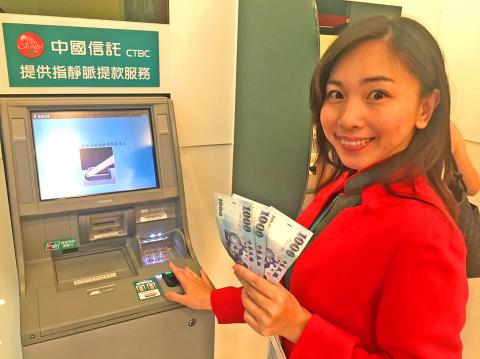CTBC Bank Co Ltd (中國信託銀行) yesterday unveiled a number of key technologies to back its transition toward the digitization of financial services, or the so-called “Bank 3.0.”
A pilot program utilizing biometirc security and mobile devices began yesterday for employees working at the 3 hectare CTBC Financial Park in Taipei’s Nangang Business Park, the company said.
The bank plans to extend the digitized services to consumers in about six months, it said.

Photo: CNA
The bank is also implementing finger vein scanning and facial recognition at its automatic teller machines (ATM), which would allow customers to withdraw money without having to use a bank card or PIN.
The finger vein technique was pioneered by the Japanese firm Hitachi Ltd and is based on the unique pattern of veins inside a finger. Only a living finger is accepted by the scanner, which is believed to make vein recognition a more secure technology than fingerprint scanning.
The finger vein sensor has a false match rate of 0.01 percent, and its accuracy in measuring the blood flow of a user for identity authentication is unaffected by variations in age and physical condition, the bank said, citing findings by US-based International Biometric Group.
The technology is already in use in some bank ATMs in Japan and Poland.
CTBC Bank said it has begun using tablets to cut down on waiting times for customers visiting branch office and is planning to transform smartphones into wallets by adding near field communication and QR Code scanning capabilities.
Consumers would to be able to make deposits, send wire transfers and take out loans by using the bank’s ATMs in 24-hour convenience stores, it said.
The digitized services are still awaiting regulatory approval and their implementation will require the consent of customers, CTBC Bank said.
However, the company said that more than 60 percent of customers still prefer face-to-face service, based on a study by Ernst & Young last year.
Additional reporting by staff writer

CHIP RACE: Three years of overbroad export controls drove foreign competitors to pursue their own AI chips, and ‘cost US taxpayers billions of dollars,’ Nvidia said China has figured out the US strategy for allowing it to buy Nvidia Corp’s H200s and is rejecting the artificial intelligence (AI) chip in favor of domestically developed semiconductors, White House AI adviser David Sacks said, citing news reports. US President Donald Trump on Monday said that he would allow shipments of Nvidia’s H200 chips to China, part of an administration effort backed by Sacks to challenge Chinese tech champions such as Huawei Technologies Co (華為) by bringing US competition to their home market. On Friday, Sacks signaled that he was uncertain about whether that approach would work. “They’re rejecting our chips,” Sacks

NATIONAL SECURITY: Intel’s testing of ACM tools despite US government control ‘highlights egregious gaps in US technology protection policies,’ a former official said Chipmaker Intel Corp has tested chipmaking tools this year from a toolmaker with deep roots in China and two overseas units that were targeted by US sanctions, according to two sources with direct knowledge of the matter. Intel, which fended off calls for its CEO’s resignation from US President Donald Trump in August over his alleged ties to China, got the tools from ACM Research Inc, a Fremont, California-based producer of chipmaking equipment. Two of ACM’s units, based in Shanghai and South Korea, were among a number of firms barred last year from receiving US technology over claims they have

BARRIERS: Gudeng’s chairman said it was unlikely that the US could replicate Taiwan’s science parks in Arizona, given its strict immigration policies and cultural differences Gudeng Precision Industrial Co (家登), which supplies wafer pods to the world’s major semiconductor firms, yesterday said it is in no rush to set up production in the US due to high costs. The company supplies its customers through a warehouse in Arizona jointly operated by TSS Holdings Ltd (德鑫控股), a joint holding of Gudeng and 17 Taiwanese firms in the semiconductor supply chain, including specialty plastic compounds producer Nytex Composites Co (耐特) and automated material handling system supplier Symtek Automation Asia Co (迅得). While the company has long been exploring the feasibility of setting up production in the US to address

OPTION: Uber said it could provide higher pay for batch trips, if incentives for batching is not removed entirely, as the latter would force it to pass on the costs to consumers Uber Technologies Inc yesterday warned that proposed restrictions on batching orders and minimum wages could prompt a NT$20 delivery fee increase in Taiwan, as lower efficiency would drive up costs. Uber CEO Dara Khosrowshahi made the remarks yesterday during his visit to Taiwan. He is on a multileg trip to the region, which includes stops in South Korea and Japan. His visit coincided the release last month of the Ministry of Labor’s draft bill on the delivery sector, which aims to safeguard delivery workers’ rights and improve their welfare. The ministry set the minimum pay for local food delivery drivers at